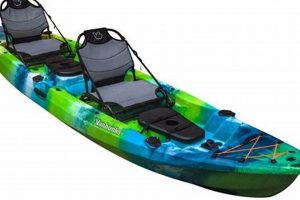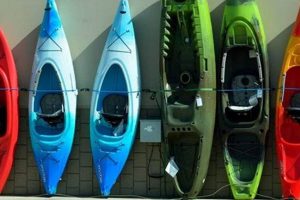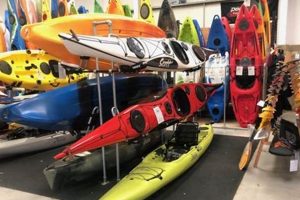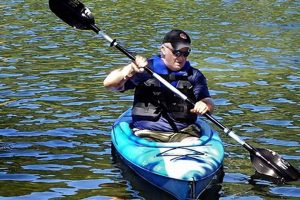This type of watercraft, a performance-oriented kayak, is designed for speed, efficiency, and maneuverability. Often longer and narrower than recreational kayaks, these vessels are typically constructed of lightweight materials like fiberglass or carbon fiber. They’re frequently used in competitive racing, fitness training, and extended touring on open water.
The sleek design and specialized features offer numerous advantages for experienced paddlers. Enhanced speed allows for covering greater distances in less time, while improved maneuverability facilitates navigating challenging currents and conditions. The lighter weight contributes to easier transport and portage. Historically, these craft evolved from traditional hunting kayaks, gradually adapting to prioritize speed and agility for sport and competition. Their development reflects a continuous pursuit of efficiency and performance on the water.
This article will delve into specific aspects of performance kayaking, exploring topics such as hull design, paddling techniques, and essential gear for optimal performance.
Performance Kayaking Tips
This section offers practical guidance for enhancing performance and safety in sport kayaking.
Tip 1: Master the Forward Stroke: A powerful and efficient forward stroke is fundamental. Focus on core engagement and a high-angle paddle entry for maximum propulsion.
Tip 2: Refine Boat Control: Develop precise edging and bracing techniques to maintain stability and maneuverability, especially in challenging conditions.
Tip 3: Optimize Body Positioning: Correct posture and a secure connection with the kayak improve efficiency and control. Maintain a relaxed upper body while engaging core muscles.
Tip 4: Select Appropriate Gear: Choose a paddle length and blade shape suitable for individual body type and paddling style. Consider lightweight, performance-oriented materials.
Tip 5: Practice Regularly: Consistent training builds strength, endurance, and refined technique, leading to improved performance and confidence on the water.
Tip 6: Understand Water Conditions: Be aware of wind, currents, and tides. Adjust paddling technique and route planning accordingly for safety and efficiency.
Tip 7: Prioritize Safety: Always wear a personal flotation device (PFD) and carry essential safety equipment. Inform someone of your paddling plans.
By focusing on these key areas, paddlers can significantly enhance their skills and enjoyment of the sport. Consistent practice and attention to detail contribute to improved performance, safety, and overall paddling experience.
This foundational knowledge prepares readers to explore more advanced techniques and specialized aspects of performance kayaking discussed in the following sections.
1. Speed
Speed represents a defining characteristic of the kayak deportivo, directly influencing its design and the paddler’s technique. Hull shape, length, and material construction contribute significantly to a boat’s potential velocity. Longer, narrower hulls with minimal wetted surface area generally produce less drag and therefore higher speeds. Lightweight materials like carbon fiber further enhance speed by reducing overall mass. A paddler’s technique also plays a critical role; efficient strokes and minimized body movement are crucial for maintaining momentum and maximizing speed potential. In competitive racing, fractions of a second can determine victory, underscoring the importance of speed in this context. Even in recreational contexts, like fitness paddling or touring, speed allows for covering greater distances and exploring more territory.
The pursuit of speed in kayak deportivo has led to continuous innovation in design and materials. From the sleek lines of racing kayaks to the lightweight construction of touring models, each design element contributes to maximizing velocity. Consider the difference between a short, recreational kayak and a long, narrow racing kayak. The recreational kayak prioritizes stability and ease of use, while the racing kayak sacrifices some stability for significantly increased speed potential. This difference reflects the varying priorities within the sport, demonstrating the direct relationship between design and intended use.
Understanding the factors influencing speed allows paddlers to make informed choices about equipment selection and technique development. Whether the goal is competitive racing or efficient touring, recognizing the impact of hull design, materials, and paddling technique is crucial for achieving optimal performance. While stability and comfort remain important considerations, speed often serves as a primary benchmark in the world of kayak deportivo, pushing both design and athletic performance to new levels. Continued advancements in hydrodynamics and materials science promise further enhancements to speed potential in the future.
2. Maneuverability
Maneuverability is a critical performance attribute in kayak deportivo, dictating a vessel’s responsiveness and control. It directly influences navigation in challenging conditions, efficient turning, and overall performance in competitive scenarios. This characteristic is determined by a combination of hull design, paddling technique, and water conditions. Understanding these factors allows paddlers to optimize their performance and adapt to varying environments.
- Hull Design:
Hull shape significantly impacts maneuverability. Shorter kayaks with a pronounced rocker (upward curve at the bow and stern) tend to turn more easily, while longer, flatter hulls offer greater tracking but reduced turning ability. Hard chines (sharp edges along the hull) increase responsiveness, particularly in edging maneuvers. Sport kayaks often prioritize maneuverability through design features that promote quick turns and agile handling.
- Paddling Technique:
Skilled paddling techniques enhance maneuverability. Sweep strokes, draws, and rudder strokes allow for precise directional control. Edging, or tilting the kayak, combines with paddle strokes to initiate and control turns. Proper technique maximizes the boat’s inherent maneuverability characteristics. Regular practice and refinement of these techniques are essential for efficient and controlled navigation.
- Water Conditions:
Water conditions, including currents, waves, and wind, significantly affect maneuverability. Strong currents can challenge a kayak’s tracking and require adjustments in paddling technique. Waves may necessitate bracing and maneuvering to maintain stability. Wind can impact both speed and direction, requiring paddlers to compensate with appropriate strokes and edging. Awareness of these conditions and adaptive paddling strategies are crucial for safe and efficient navigation.
- Competitive Advantage:
In competitive kayaking, maneuverability often provides a decisive edge. Quick turns and precise boat control are essential for navigating tight race courses and outmaneuvering competitors. The ability to efficiently change direction and maintain speed through turns can be the difference between winning and losing. Therefore, athletes often prioritize maneuverability when selecting kayaks and dedicate significant training time to perfecting maneuvering techniques.
The interplay of these factors defines a kayak’s maneuverability profile. A well-designed sport kayak, combined with proficient paddling technique and an understanding of water conditions, allows for precise control and efficient navigation. From competitive racing to recreational paddling, maneuverability contributes significantly to overall performance and enjoyment on the water. It empowers paddlers to navigate complex environments, execute precise maneuvers, and ultimately, experience the full potential of kayak deportivo.
3. Efficiency
Efficiency in kayak deportivo translates to maximizing speed and distance with minimal energy expenditure. This crucial element encompasses several interconnected factors, including hull design, paddling technique, and equipment selection. A streamlined hull minimizes drag, allowing the kayak to glide through the water with less resistance. An efficient paddling technique, employing proper body mechanics and blade control, optimizes power transfer and reduces wasted energy. Lightweight equipment further contributes to overall efficiency by minimizing the mass that needs to be propelled.
Consider the impact of hull design on efficiency. A longer, narrower hull displaces less water and creates less drag, leading to improved glide and higher speeds with the same effort. Compare this to a shorter, wider recreational kayak, which experiences greater resistance and requires more energy to achieve comparable speeds. Similarly, an efficient forward stroke, utilizing core rotation and a high-angle paddle entry, maximizes propulsion while minimizing fatigue. Conversely, a poorly executed stroke, with excessive splashing or incorrect blade angle, wastes energy and limits speed. The cumulative effect of these factors significantly impacts performance, particularly during longer paddles or races.
The pursuit of efficiency in kayak deportivo drives continuous innovation in design and technique. From minimizing hull friction through specialized coatings to optimizing paddle blade shapes for enhanced propulsion, the focus remains on maximizing performance with minimal effort. This understanding allows paddlers to make informed choices about equipment and training, ultimately leading to enhanced speed, endurance, and overall enjoyment of the sport. Choosing a lightweight kayak constructed from materials like carbon fiber reduces the overall mass and enhances efficiency. Similarly, investing time in developing a smooth and powerful forward stroke yields significant gains in speed and distance covered. By prioritizing efficiency, paddlers can unlock their full potential on the water.
4. Lightweight Construction
Lightweight construction is paramount in kayak deportivo, directly influencing performance characteristics such as speed, maneuverability, and ease of transport. Reducing a kayak’s mass minimizes inertia, requiring less energy for acceleration and deceleration. This translates to faster speeds, quicker turns, and reduced fatigue during longer paddling sessions. Furthermore, a lighter kayak is easier to carry and transport, a significant advantage for athletes and recreational paddlers alike.
- Materials:
Material selection is crucial for achieving lightweight construction. Modern sport kayaks often utilize advanced composites like carbon fiber, fiberglass, and Kevlar. These materials offer high strength-to-weight ratios, allowing for robust yet lightweight construction. Carbon fiber, known for its exceptional stiffness and lightness, is a premium choice for high-performance kayaks, while fiberglass and Kevlar offer more affordable alternatives with varying performance characteristics. The choice of material depends on the intended use and budget considerations. For instance, a racing kayak might prioritize the ultra-lightweight properties of carbon fiber, while a recreational touring kayak might opt for the durability and affordability of fiberglass.
- Construction Techniques:
Advanced construction techniques further contribute to minimizing weight while maintaining structural integrity. Vacuum bagging and resin infusion processes remove excess resin, reducing overall mass without compromising strength. Thermoforming and rotomolding techniques offer efficient production methods for creating lightweight kayaks with consistent quality. These techniques enable manufacturers to precisely control the thickness and distribution of materials, optimizing both weight and performance. For example, vacuum bagging ensures a uniform distribution of resin and fibers, resulting in a lighter and stronger hull compared to traditional hand-layup methods.
- Performance Benefits:
The benefits of lightweight construction extend beyond reduced effort. A lighter kayak accelerates and decelerates more readily, enabling quicker turns and more agile maneuvering. This is particularly advantageous in competitive racing and dynamic paddling environments. Reduced weight also contributes to easier portaging and transport, simplifying logistics for both training and recreational paddling. Whether carrying a kayak across a beach or loading it onto a vehicle, the reduced weight makes handling significantly easier. Consider the difference between carrying a 30-pound carbon fiber kayak versus a 50-pound polyethylene kayak; the lighter option significantly reduces strain and simplifies transport.
- Trade-offs:
While lightweight construction offers numerous advantages, it’s important to consider potential trade-offs. Ultra-lightweight kayaks can be less durable and more susceptible to damage from impacts or abrasion. They also tend to be more expensive due to the higher cost of materials and manufacturing processes. Balancing weight, durability, and cost is essential when selecting a kayak for specific needs and paddling conditions. For instance, a recreational paddler might prioritize durability over extreme lightness, while a competitive racer might accept some compromises in durability to gain a performance edge from reduced weight.
In the realm of kayak deportivo, lightweight construction plays a pivotal role in optimizing performance and enhancing the overall paddling experience. By carefully considering materials, construction techniques, and the inherent trade-offs, paddlers can choose kayaks that meet their specific needs and maximize their potential on the water. The relentless pursuit of lighter, stronger, and more efficient kayaks continues to drive innovation in materials science and manufacturing processes, pushing the boundaries of performance in this dynamic sport.
5. Specialized Design
Specialized design distinguishes kayak deportivo from recreational models, optimizing performance characteristics for specific paddling disciplines. This design philosophy prioritizes speed, maneuverability, and efficiency through meticulous hull shaping, deck layouts, and material selection. Understanding these design elements is crucial for selecting the right kayak for specific paddling needs and goals.
- Hull Design:
Hull design significantly influences a kayak’s performance characteristics. Longer, narrower hulls with a reduced wetted surface area minimize drag, promoting higher speeds. A pronounced rocker, characterized by an upward curve at the bow and stern, enhances maneuverability in waves and rough water. Flatter hulls offer increased primary stability, while rounded or V-shaped hulls enhance secondary stability (the ability to recover from a tilt). Sport kayaks often incorporate specialized hull features like hard chines (sharp edges) for improved edging and responsiveness. For example, a racing kayak might feature a long, narrow hull with minimal rocker for maximum speed on flat water, while a whitewater kayak would prioritize a shorter, rockered hull for maneuverability in turbulent conditions. The selection of hull design depends heavily on the intended paddling discipline and the desired balance between speed, stability, and maneuverability.
- Deck Layout:
Deck layout contributes to both comfort and performance. Adjustable foot braces and seat backs allow paddlers to customize the fit and optimize body positioning for efficient power transfer. Integrated hatches and storage compartments provide convenient access to gear and supplies during longer trips. Cockpit design varies depending on the paddling discipline; racing kayaks often feature smaller cockpits for a snug fit and reduced wind resistance, while touring kayaks may have larger cockpits for easier entry and exit. Consider the difference between a surfski’s open cockpit, designed for self-bailing in rough water, and a sea kayak’s closed cockpit, offering protection from the elements during extended expeditions. The deck layout reflects the specific needs and priorities of different paddling styles.
- Material Selection:
Material selection significantly impacts a kayak’s weight, durability, and performance. Lightweight composites like carbon fiber and fiberglass are favored for their high strength-to-weight ratios, enhancing speed and efficiency. Thermoplastic materials like polyethylene offer greater durability and affordability, making them suitable for recreational use. The choice of material depends on factors such as budget, intended use, and desired performance characteristics. A high-performance racing kayak might utilize lightweight carbon fiber for maximum speed, while a recreational kayak might opt for the durability of rotomolded polyethylene. Material selection represents a crucial design consideration, balancing performance, durability, and cost.
- Specialized Features:
Specialized features further enhance a kayak’s performance for specific disciplines. Racing kayaks often incorporate rudders or skegs for improved tracking and directional control. Whitewater kayaks feature specialized hull shapes and outfitting for navigating rapids and performing advanced maneuvers. Touring kayaks often include ample storage space and deck rigging for carrying gear on extended expeditions. These specialized features reflect the unique demands of different paddling disciplines, demonstrating the targeted design approach of kayak deportivo. For example, a sea kayak might include bulkheads for flotation and storage, while a fishing kayak might incorporate rod holders and specialized hatches for tackle storage.
These specialized design elements, working in concert, distinguish kayak deportivo from recreational models. By understanding the interplay of hull design, deck layout, material selection, and specialized features, paddlers can choose the optimal kayak for their chosen discipline and achieve peak performance on the water. This specialized design philosophy reflects the continuous evolution of kayaking, pushing boundaries and optimizing performance for diverse paddling pursuits.
6. Competitive Racing
Competitive racing represents a pinnacle of kayak deportivo, pushing the boundaries of both athletic performance and equipment design. This demanding discipline requires specialized kayaks, rigorous training, and a deep understanding of racing strategies. The following facets highlight the key components of competitive kayak racing.
- Boat Categories:
Competitive kayak racing features distinct boat categories based on factors such as hull design, paddler capacity (single or double), and paddling distance (sprint, marathon, or surfski). These classifications ensure fair competition and allow athletes to specialize in specific disciplines. Sprint kayaks, for example, are designed for short, high-intensity races on flat water, while surfski races cover longer distances in open ocean conditions, demanding different hull designs and paddling techniques. Each category has specific regulations governing boat dimensions and construction materials, ensuring a level playing field for competitors.
- Race Formats:
Race formats vary depending on the discipline and competition level. Sprint races typically involve multiple heats and finals over short distances, often 200, 500, or 1000 meters. Marathon races cover significantly longer distances, often requiring navigational skills and endurance management. Surfski races navigate open ocean courses, demanding both speed and wave-riding proficiency. Understanding the specific rules and strategies for each race format is crucial for competitive success. For example, sprint races demand explosive starts and sustained high-intensity paddling, while marathon races prioritize pacing and efficient energy management.
- Training Regimens:
Competitive kayakers follow rigorous training regimens to develop strength, endurance, and technical proficiency. Training typically includes on-water paddling sessions, strength and conditioning workouts, and flexibility exercises. Paddlers often focus on specific muscle groups essential for kayaking, such as core, back, and shoulder muscles. Interval training, incorporating high-intensity bursts with periods of rest or lower intensity paddling, helps develop anaerobic capacity and speed endurance. Nutritional strategies and recovery protocols further contribute to optimal performance. Competitive training demands dedication, discipline, and a comprehensive approach to physical conditioning.
- Strategic Considerations:
Beyond physical prowess, competitive racing requires strategic thinking and tactical execution. Paddlers must analyze race conditions, including wind, currents, and competitor positions, to develop effective race plans. Drafting behind other paddlers can conserve energy and provide a strategic advantage. Efficient turning techniques and strategic positioning within the pack are critical for maximizing speed and gaining an edge over competitors. Mental focus and the ability to adapt to changing race dynamics are essential attributes for success in competitive kayaking. The ability to anticipate and react to competitors’ moves, along with precise execution of race strategies, can significantly impact the outcome of a race.
These facets highlight the demanding nature of competitive kayak racing within the broader context of kayak deportivo. The specialized equipment, rigorous training, and strategic considerations demonstrate the dedication and skill required to excel in this challenging and rewarding sport. From sprint races on calm lakes to marathon challenges in open water, competitive racing showcases the versatility and athleticism of kayak deportivo, pushing the boundaries of human performance on the water.
7. Fitness and Touring
Fitness and touring represent significant applications of kayak deportivo, leveraging the inherent performance characteristics of these specialized craft for both physical conditioning and recreational exploration. The connection between fitness/touring and kayak deportivo stems from the design features that prioritize efficiency, speed, and maneuverability. These attributes enable paddlers to cover greater distances, navigate varied water conditions, and engage in physically demanding activities, enhancing both fitness levels and the touring experience.
The lightweight construction and streamlined hulls of sport kayaks contribute directly to efficient paddling, requiring less energy to maintain speed and cover distance. This efficiency translates to longer, more challenging workouts for fitness enthusiasts and enables extended touring trips with reduced fatigue. Furthermore, the enhanced maneuverability of sport kayaks allows paddlers to navigate challenging currents, wind, and waves, opening up opportunities for exploration in diverse environments. Consider a multi-day kayaking trip along a scenic coastline; a stable, efficient touring kayak enables exploration of remote coves and inlets, maximizing the touring experience. Similarly, interval training sessions in a fast, responsive sport kayak provide a challenging cardiovascular workout while honing paddling technique.
The synergy between fitness/touring and kayak deportivo underscores the versatility of these specialized craft. The inherent performance characteristics translate directly to practical benefits for both fitness enthusiasts and recreational paddlers. While competitive racing often occupies the spotlight within kayak deportivo, the applications in fitness and touring represent significant and accessible avenues for experiencing the performance advantages of these specialized kayaks. Understanding this connection empowers individuals to select the appropriate kayak and develop paddling skills that align with their fitness and touring goals, ultimately enriching their overall experience on the water.
Frequently Asked Questions about Sport Kayaks
This section addresses common inquiries regarding sport kayaks, providing concise and informative responses to clarify key aspects and assist individuals in making informed decisions.
Question 1: What differentiates a sport kayak from a recreational kayak?
Sport kayaks prioritize speed, efficiency, and maneuverability, often featuring longer, narrower hulls and lighter construction compared to recreational kayaks. They are designed for activities like racing, fitness paddling, and extended touring.
Question 2: What materials are commonly used in sport kayak construction?
Common materials include fiberglass, carbon fiber, and Kevlar composites, chosen for their strength-to-weight ratios. Thermoplastic materials like polyethylene are also used in some sport kayaks, balancing durability and affordability.
Question 3: How does hull design influence a sport kayak’s performance?
Hull design significantly impacts speed, stability, and maneuverability. Longer, narrower hulls enhance speed, while rockered hulls improve maneuverability in rough water. The hull shape also affects primary and secondary stability, crucial factors for different paddling conditions.
Question 4: What are the essential features to consider when choosing a sport kayak?
Essential features include hull design, cockpit size and configuration, seat adjustability, storage capacity, and rudder/skeg systems (if applicable). Consider paddling style, intended use, and individual preferences when selecting a kayak.
Question 5: What are the typical price ranges for sport kayaks?
Prices vary widely depending on materials, construction, features, and brand reputation. Entry-level sport kayaks can range from several hundred to a few thousand dollars, while high-performance racing kayaks can exceed several thousand dollars.
Question 6: What safety precautions should one take when paddling a sport kayak?
Always wear a personal flotation device (PFD) and carry essential safety gear, including a whistle, signaling device, and bilge pump. Inform someone of paddling plans, including route and estimated return time. Be aware of weather conditions and water hazards.
Understanding these key aspects facilitates informed decision-making when selecting and using a sport kayak. Careful consideration of individual needs, paddling goals, and safety precautions ensures a positive and rewarding experience on the water.
The information provided here serves as a starting point for further exploration of sport kayaking. Consulting with experienced paddlers and retailers can provide additional insights and guidance tailored to specific needs and interests. Further sections of this article will delve into specific aspects of kayak selection, paddling technique, and advanced training methods.
Conclusion
This exploration of sport kayaking, encompassing design principles, performance characteristics, and practical applications, reveals a specialized pursuit demanding both athleticism and technical understanding. From the hydrodynamics of hull design to the nuanced techniques of competitive racing, the multifaceted nature of the sport becomes evident. Lightweight construction materials, specialized design features, and rigorous training regimens contribute to the pursuit of speed, efficiency, and maneuverability on the water. The examination of competitive racing, fitness paddling, and recreational touring further highlights the versatility and diverse applications of sport kayaking.
The continuous evolution of design and technology promises further advancements in performance and accessibility within sport kayaking. As materials science and hydrodynamic understanding progress, the potential for enhanced speed, efficiency, and control remains a driving force. This ongoing development invites both seasoned athletes and aspiring paddlers to explore the dynamic and rewarding world of sport kayaking, pushing boundaries and experiencing the unique connection between human potential and the aquatic environment.






